The low-mileage car gets a road trip
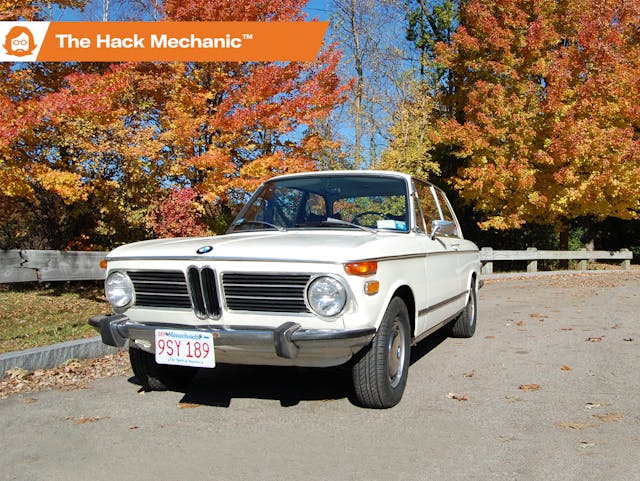
I’ve written repeatedly about “Hampton,” the remarkably original survivor 1973 BMW 2002 that I bought in Bridgehampton, Long Island, from its original owner 3 1/2 years ago. Part of the appeal of the car was that, when I bought it, it had 48,125 documented original miles that aligned with its intact survivor vibe.

Now, 48,000 miles is a funny number. It’s not remotely in the same league as the sub-thousand-mile cars that get bid up to crazy prices on Bring a Trailer. But a BMW 2002 with that mileage is a rare beast. When I bought my ’74 Lotus Europa Twin Cam Special nine years ago, it had 24,000 miles on it. That’s not why I bought it, but I did think that the mileage made it something special. I was completely wrong. There appear to be a fair number of Europas, particularly Twin Cam cars, with that kind of mileage on them, because a) They were generally bought as third, not first or even second cars, b) The water pump is integrated with the front timing cover, the seal leaks from sitting, and because of the mid-engine design, the engine has to be removed to rebuild the pump, which is part of the reason behind c) the widely-repeated saying that Lotus stands for “Lots Of Trouble Usually Serious.”

But a BMW 2002 isn’t like that. These cars were bought as primary transportation, owners drove the wheels off them, and they were and continue to be generally quite reliable, making sub-50,000-mile 2002s pretty uncommon. When I bought Hampton in the spring of 2019, it had been sitting in a barn for a decade due to a change in family fortunes. I don’t usually flip cars, but I saw dollar signs. I cleaned it up, sorted it out, put it on Bring a Trailer, and was surprised when it didn’t meet a reasonable reserve. I think the main reason why was that although folks say that they love original survivor cars (“It’s only original once,” and all that), BaT’s click-and-bid-bid-bid machinery is more hospitable to eye-candy cars with powder-coated subframes and dry-ice-blasted engine compartments, neither of which Hampton has. I wasn’t planning on keeping the car, but when it didn’t sell, that seemed to be my lot, at least for a while.
During this unexpected second act of the play of ownership, I’ve been very conscious not to rack up the mileage. Virtually all the 800-ish miles I put on the car was running it back and forth to the warehouse in central Massachusetts where I rent space. I never really “pleasure-drove” it anywhere. While some component of that was that the nearly-bone-stock Hampton doesn’t have the snap of my fuel-injected 2002tii or my other 2002, with its high-compression twin-Webered-and-cammed engine, the bigger reason was that I was adamant about not rolling it over to 49,000 miles (“le petit rollover”), much less 50,000 (“le grande rollover”).
However, over the past few months, there was a shift in my thinking. First, the idea of hoarding mileage—owning a car and not driving it because of worry that that will affect its value—is antithetical to everything that I do. The value of Hampton will be increased by a) detailing the engine compartment and undercarriage (the latter of which will likely never happen), b) wire-brushing, treating, and repainting the little bit of seam rust on the hood and the door bottoms, c) having paintless dent removal performed on the little dings, and d) the passage of time. I now realize that zeroing in myopically on the mileage and saying the car be worth $Y with 49,000 on it but only $X with 51,000 is just plain silly.
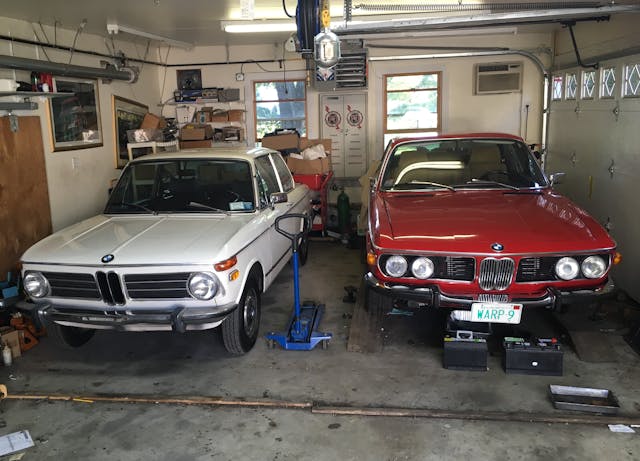
Second, even though the other 2002s, the Lotus, the BMW M Coupe, and other cars are well-ahead of it in the pleasure-driving queue, Hampton is the prettiest 2002 I own, and its survivor vibe gets under your skin. The original paint and bone-stock interior are often conversation pieces. I had a guy chat me up recently outside a liquor store and ask if he could smell the car’s interior. Rather than look at him askance, I understood the request completely. The horsehair padding (“Gummihair,” as the Germans called it) of the seats has a very characteristic smell. He opened the door, stuck his head in, inhaled deeply, and smiled. “That is exactly how a BMW 2002 is supposed to smell,” he said. He was right.
And so I began to use the car more. After identifying and fixing a long-standing hard-starting problem, I focused on another carburetor issue, that of lean-running. Using a portable exhaust gas analyzer I bought 40 years ago in a pawn shop in Austin, I verified my suspicion that the car’s hesitation at even throttle and numbness on modest acceleration was indeed accompanied by the meter on the gas analyzer swinging well into the lean zone. I ordered an assortment of idle and main jets, and with a little tweaking, was able to a) get the needle on the gas analyzer to sit much closer to the middle, b) the hesitation to go away, and c) the car to wake up when I squeezed the throttle.

But while iteratively doing that, I was running the car a few exits up and down I-95 and put another hundred or so miles on it. As I homed in on the final jetting, I didn’t cringe as the odometer did le petit rollover to 49,000 miles. Instead, I smiled at the fact that I’d largely let go of the “I shouldn’t be driving it” issue and was actually performing useful tuning that would increase my driving enjoyment.

Since my usage of the car was increasing, I installed a spare Recaro-like Konig driver’s seat I had in the basement. While I absolutely love the look of BMW’s 1970s seat pleating, the big wide, flat horsehair-padded seats are uncomfortable for anything other than short drives, and with my back injury in August, I need all the lumbar support I can get. Plus, for enthusiastic driving, the bolstered seat held me in place much better. Not that I was sliding the car around entrance ramps. That would be pleasure driving (haha).

I was so pleased with this shift in tone and purpose that I decided that Hampton deserved something of a coming-out party. After all, even close friends of mine in the vintage BMW world had never seen the car. One good friend joked that the car was an urban myth. So, I took it to “BMW Day” at the nearby Larz Anderson Auto Museum in Brookline, Massachusetts. There were any number of cool cars there, including a survivor 1935 315/1 roadster, so it’s not like Hampton was the belle of the ball. But enough of my local 2002 friends laid eyes on it to retire the “urban myth” joke.
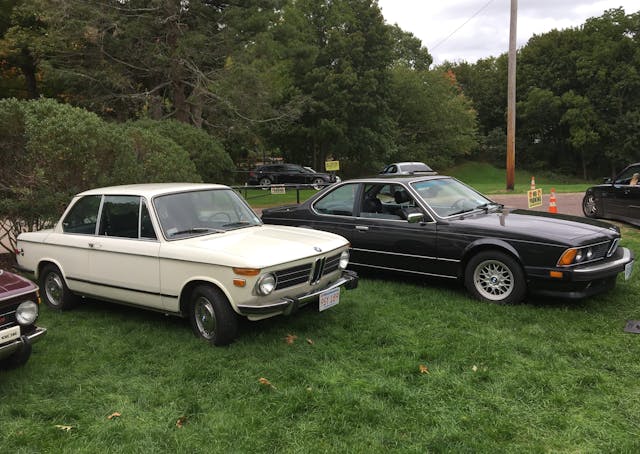

In fact, it got the gears turning in my brain to something bigger:
Road trip!
The following weekend, my wife, Maire Anne, and I were planning to drive up and see some close friends in Manchester, Vermont, one of whom is a former bandmate who had asked me to sit in with his band in a gig they had during Columbus Day / Indigenous People’s Weekend outside the Orvis building. Road trips in smelly, old, vintage cars aren’t really my wife’s thing, so I was planning on taking my smooth and quiet 2003 BMW 530i. Plus, rain was forecast, and as much as I love pounding out big miles in the vintage cars, driving them in drenching rain is stress-inducing to the driver and rust-inducing to the car.
However, the morning we were planning to leave, I looked at the weather radar, and it showed that the precipitation bands were predicted to head well north of our destination, so any rain was likely to be episodic rather than drenching. I ran the smelly-old-vintage-car question past my better half, and she signed off on it, so into the trunk went the Tech21 guitar amp, and onto the back seat went the Peavey T-60 and the Taylor GS guitars. The projected 150-ish-mile trip was a Goldilocks-just-right distance, as I felt comfortable bringing a toolbox and a few reasonable spares (fuel pump, distributor cap, plugs and points, fan belt) but eschewing the floor jack, two gallons of antifreeze, timing light, and more that I’d take on a real road trip.

We had a picture-perfect drive up through fabulous foliage. The windows were down and the sunroof open for most of it. As we approached Manchester, we could see the storm center hovering ominously off to the northeast, but although the temperature dropped about 15 degrees, there was absolutely zero rain.

The only problem we had on the trip was that my supposed hard-starting fix last month wasn’t the magic bullet I thought it was. With the colder overnight temperatures, the car had trouble starting in the morning. Adjusting the automatic choke so it rotated hard closed didn’t fix it. Then the problem started happening even when the engine was warm. Fortunately, I brought a battery jump pack just in case I ran the battery down and needed to self-jump, which I did. Curiously, starting with a fully open throttle turned out to be the magic trick. I’m still not sure what the cause of the problem is. But all in all, it was no more than a minor annoyance.
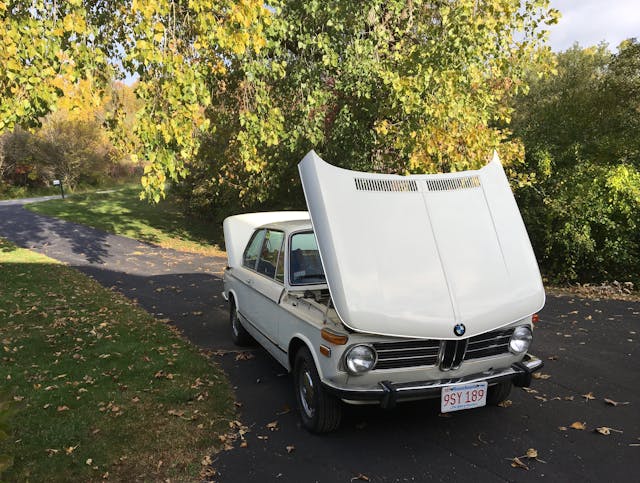
One of the reasons BMW 2002s had a cult following when they were new is that they were small sports sedans that did a lot of things well. They were stout, had an acceptable amount of power, could seat four, had a real trunk, and were almost criminally smile-inducing on a curvy road. All of that is still true. Further, while there’s no pretending that you’re not in a 50-year-old car in terms of wind noise, the car’s two-liter engine, snickety four-speed gearbox, front disc brakes, McPherson strut front suspension, and fully independent rear suspension still make the 2002 a joy to drive. That can’t be said of all vintage cars. I may have missed the extra power and the wonderful wind-up of the 2002tii when I wanted to squeeze the accelerator to keep pace with traffic up a hill, or the roar of the dual Webers and the hot cam when I wanted to mash and pass, but what Hampton lacked in snap, it more than made up for in panache.
In addition, not only were Maire Anne and I happy road-tripping the perky little 2002, Hampton seemed happy. Before the car was put in storage in 2009, it had been a summer car in the Hamptons, used only to tool around between a vacation home and the beach. This was probably its first road trip in over 20 years. Deciding to drive the car, to use it as intended instead of hoarding its mileage like virginity in a 19th century British novel or vintage scotch seemed to lift a pall that had descended upon it after it didn’t sell on BaT and I stuffed it away.
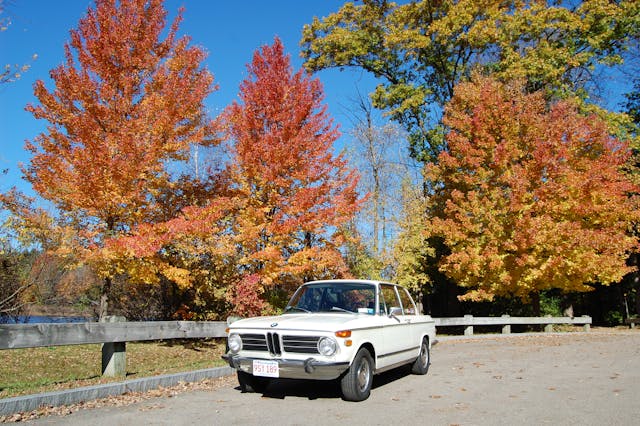
The roughly 310-mile round-trip ticked the mileage up to 49,365. I can’t say that I’m going to start planning road trips in the car to Nome or Seattle or even Asheville. It still is likely this car is sojourning with me rather than a long-term soulmate. And I have other cars, and they all get their turn. But that’s the point—Hampton is now getting its turn with the rest, and I will now use the car for what I want instead of feeling like keeping the mileage down is the single most important thing.
After all, when le grande rollover happens, the car and I should be livin’ the dream on some road trip, not running cardboard boxes down to the recycling depot. Or getting an inspection sticker. Or tweaking the jetting on I-95.
***
Rob Siegel’s latest book, The Best of the Hack MechanicTM: 35 years of hacks, kluges, and assorted automotive mayhem, is available on Amazon. His other seven books are available here, or you can order personally inscribed copies through his website, www.robsiegel.com.

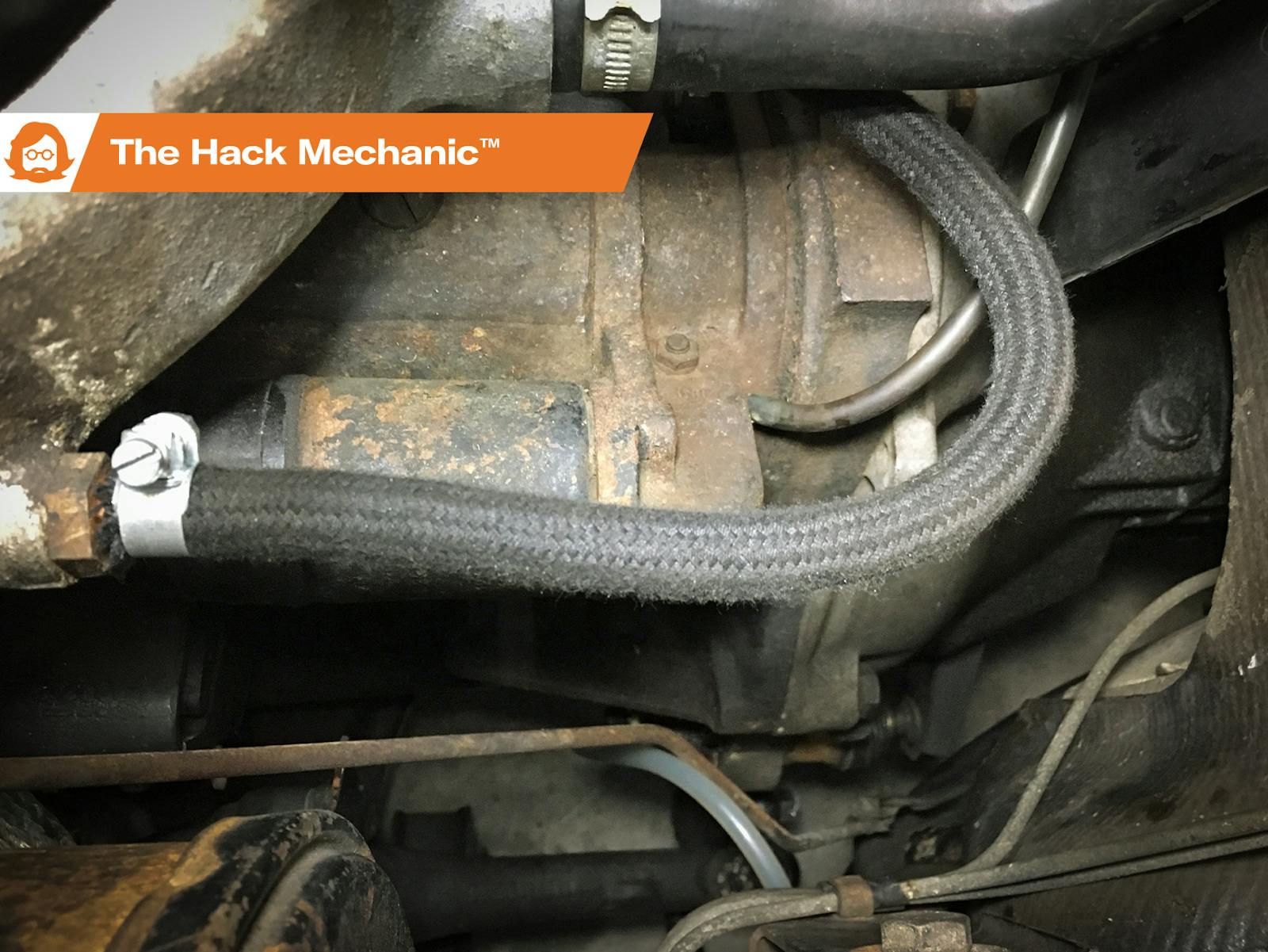
You have to drive cars at least once in a while to keep the seals in good shape and to find any problems before they become major. Occasional road trips or a few times to work won’t hurt. It’s not like you are going to put 100,000 miles a year on it. You have to enjoy the driving experience otherwise it’s just a museum piece. There is a place for museum pieces for the ultra rare, but Jay Leno gets his out regularly for exercise.
Around seven years ago I purchased a 1975 Cosworth Vega. It was common for people to buy these new back in the 1970’s and put them away. When I bought it, the car was around 40 years old, and the two prior owners only drove it a total of 750 miles. It still had a new car smell inside, and even the clock still worked. I could have left it as a time capsule. Though I asked myself, who was I saving it for? I decided the prior two owners saved it for me. I’ve since put about 300 miles per year on the car, and I enjoy driving it, it’s like driving a 40 year old new car. While it’s wonderful to own collector cars even just to look at them, it’s far better to drive them. If they’re not concours show cars, we might as well enjoy them, life is short!
What a lovely car! I had a 1802, yearmodel 1973, which I drove in seven years (between 1989 and 1996) and about 120.000 kilometer with no problems at all. A soft, reliable and comfortable car.
/ Steve in Sweden
Low mileage original cars are like time machines; it’s really worthwhile to take a ride and relive & savor the experience that endears them to us. Whether the odometer reads 48,000 or 51,000 miles, it’s still a low-mileage original car, and any value reduction is like splitting hairs. Enjoy the car, rather than regret not experiencing it. We only get one pass on this planet, right ?
Agreed. I rolled over 61,000 on my original paint ’66 Beetle last year. It had 58,000 when I got it a bit more than a decade ago. I had a lot going on for several years, so now I’m trying to enjoy it and not worry too much about accumulating mileage. It’s much more fun that way and it wouldn’t be worth a life-changing amount of money no matter the mileage, so who am I saving it for? (The answer is ‘me’!)
I have a all-original ’63 Beetle from Buffalo, New York. It was put away in 1985. Brought out in 2009 and only had 1,000 miles put on it. I went through things which took some time. However, as much as I want to preserve this car, I still want to drive it. I just rolled 68,000 miles last weekend. I think that is still low mileage. The more I drive the car, the better it runs! It’s not a $100K car and they’re meant to be driven and enjoyed. I agree with the one pass on this planet comment above. Enjoy them while you can! I’m currently working on a true “Barn Find” ’57 Beetle, which will be driven as well. All my cars main purpose are to be driven and enjoyed!
Rob as an ex owner, enthusiastic driver of a 1969 Roundie I have to agree with everything you say about Hampton. I have owned somewhere between 2 and 300 cars from the mundane to the superlative, English, American, French, Italian, Japanese, Korean etc. since my first in 1956 and Colo, my cars nickname as it was painted Colorado, is far and away the car that I have had the most enjoyment out of and if I HAD to have just one of them back to last the rest of my life, it would be the 2002. Great write-up Rob.
Bought a 1996 850ci in 2020 with 43k on the odometer, try to drive every weekend.
You should drive all and any cars on a regular basis.
As for road trips I warn causation. If it is. Low miles keep in mind sitting takes a toll and longer trips can bring out the way weakness.
If you plan to drive change belts and hoses at a minimum. Water pumps are not a bad idea.
These areas are weak spots. Also check the exhaust as they can rot off just sitting if they are mild steel and not stainless. Even Stainless welds need investigated.
I do a two hour run once a year along with my local runs to events. This is just far enough to keep the car in shape and run a tank of fuel out. But it is not so far I could not easily get the car home.
Also run the air to keep the seals working.
I have a 71 Chevy C 20 with a high degree of originality. 402 BB, TH400, PS, PB, air, tilt wheel, factory tach. Cheyenne Super package. Red and white. I bought it three years ago out of CA with 71,000 original miles. This is my daily driver when there is no salt on the roads here in northern Michigan. It is a joy to drive and makes people smile. It now has 75,000 miles and I don’t regret a single one. Yes, it is “irreplicable” but so is the happiness it brings me.
I recently used it to tow my 66 Chevelle SS to a car show about an hour away from us. Unloaded and put both in the show. Had a ball. No issues whatsoever. This truck was built to work and I intend to keep it on the job.
The other extreme is a 1972 Porsche 911 E I just found in a barn near us. It had sat for 22 years, only driven about 50 miles in that time. The engine had just been rebuilt, so new seals there. The shift rod seal on the transmission, however, had dried out over time and allowed a quart or two of gear lube to drain into the interior floor. (Long story…911 owners will get it) So I will be pulling the drivetrain and renewing the transmission seals soon.
So bottom line is DRIVE your cars!
If you’re not driving it, you’re killing it!! My 57 Thunderbird gets 1000 miles put on it every year and now has just over 66000 miles which by any guess is still low mileage in my books. Once the warranty is gone low mileage means nothing if it is rust and rot free.
I have a older (1997) Volvo Turbo that has comparatively low miles. I drive it every day when I can. I enjoy the experience – and it also keeps the vehicle somewhat limber.
Maybe it’s just me, but I can’t fathom owning this car and NOT driving it. What’s the point of owning a classic vehicle if it’s just viewed at as a financial investment that sits in the garage and receives a coat of wax every so often? I think Leno has it right: he owns a vehicle because he wants to drive it.
When you decide to part company give shoot me an email and a price! It would be a great stablemate for my 1997 Z3 that I’ve owned since 1999. My friend’s father’s 2002 is the reason I fell for BMW’s long ago.
I feel the same way about my 1982 DMC-12 Delorean. I occasionally take it some local car shows, but usually it just sits in my Pole Barn to hooked up to the battery tender. I had been trying to keep the mileage on the downside, but when I went past 29,999 mile this summer, I realized this was no big deal. I’ve had the car for 13 years and still enjoy taking it out for a ride. You forget the reason you bought the damn car was you wanted to drive it. So, drive enjoy your toy and forget the occasional mileage you will add to the clock. Probably doing more good than harm by circulating all the fluids in the car (Brakes, AC freon, coolant). Just my 2 cents worth.
I’m not afraid to put up to 2,500 miles a year on all our classics. It’s good to drive them, and they pay me back by running perfectly and providing a driving pleasure that exceeds expectations every time.
I have found myself in hospitals twice, not knowing if I would survive. I have no intention of “saving it for the next guy” because our time is limited. Enjoy what you have. If you get caught in the rain, turn the wipers on.
I owned 2 2002’s back in the 1970-80’s. Their carburetors were notoriously bad, so the common fix back then was a replacement Weber and corresponding intake manifold.
Not sure such still can be found, but it really solved the issue.
Sheesh, Rob, I’m glad you finally got over your obsession with preservation of low mileage. But maybe you still need to loosen up some more. I suggest you start frequenting Mileage Impossible on FB, where you can read about some very ordinary cars that have exceeded half a million miles, and even a few that have approached a million. Heck, Irv Gordon would have never gotten beyond a million, let alone to 3 million in his ’66 Volvo P1800 had he suffered from that obsession.
http://www.thetruthaboutcars.com/2014/02/the-man-for-whom-they-made-the-three-million-mile-badge/
Yep my family used to own a 76 Celica that had 125k on it when my little brother bought it in college .
It had about 375k on it when he bought a nicer newer car to use as a daily.
It never left the family, and I used it as my daily commuter for years when I had a job that required parking my car in a dusty gravel truck terminal.
Then it was getting close to 480k and got rear ended , but we kept driving it .
We really wanted to see the rollover at 500k
And we finally did ,
After two junkyard engines , two head gaskets , and a junkyard back axle and two repaints , it rolled over for the fifth time and we gave it away to another family member to drive in high school